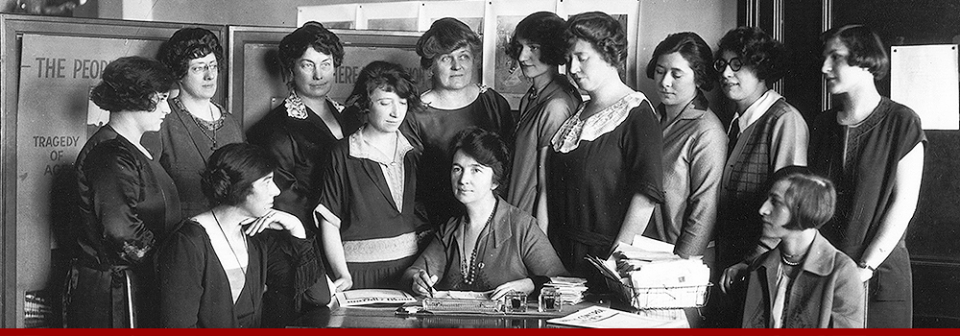On January 2, 1923, Margaret Sanger opened the first legal birth control clinic in America, The Birth Control Clinical
Research Bureau (BCCRB). In 1916, Sanger opened a trial clinic in Brooklyn to challenge New York State law. She was arrested and served a term of 30 days. The case was appealed and in 1918, the Court of Appeals ruled that a licensed physician could provide “information for the cure or prevention of disease.” This decision provided a precedent for physicians in New York State. In accordance with this decision, in 1923, Margaret Sanger financed and organized the BCCRB under the medical direction of a female physician to advise and instruct patients. By the 1930s, the BCCRB served well over 10,000 patients each year and trained thousands of doctors and nurses. In “The Practice of Contraception”(Sanger, M. and Hannah Stone, 1931), Dr. Hannah Stone defined the functions of the BCCRB as,
(1)To advise and instruct women and properly equip them in contraceptive knowledge; (2) To evaluate the worth of various contraceptive methods; (3) To carry on clinical research in contraceptive methods and technique; (4) To instruct physicians who may desire to observe and learn the methods and technique of contraception; (5) To collect and correlate the many data concerning the social, economic, medical and sexual lives of our patients.” (200)
In the 1930s the BCCRB was the most important birth control organization for clinic activists. The first priority of the BCCRB was to treat patients but it also tested and reported effectiveness of contraceptives, analyzed and reported on patients’ experiences, created instructional literature, and provided training for doctors and nurses. The BCCRB also established a nationwide network of affiliated clinics and supervised numerous field projects in the rural south. Clinic staff worked in close association with Sanger’s National Committee for Federal Legislation for Birth Control (NCFLBC), and promoted the inclusion of contraceptive instruction in public health programs throughout the country. The clinic’s detailed follow-up work with patients and careful record-keeping enabled medical researchers, contraceptive manufacturers, and associated clinics to study the effectiveness and safety of particular forms of birth control, including the diaphragm and jelly, condom, and the rhythm method.
The BCCRB sought to operate within the constraints of New York State law, which stated that doctors could prescribe contraceptives only for the prevention or cure of a disease, including tuberculosis, syphilis, and various types of psychoses. The BCCRB broadly interpreted the law to allow parents interested in spacing their children to be eligible for contraceptive information, while treating countless other patients under a catchall of medical indications, such as general debility. The Bureau was challenged on several occasions for illegally dispensing birth control devices and information, most notably in April of 1929 when police raided the clinic, seized records and equipment, and arrested Medical Director Dr. Hannah Stone, along with four other staff members. A judge later dismissed the charges citing insufficient evidence. The raid generated significant publicity for the clinic and helped secure long-sought support from New York’s medical establishment, which emphatically condemned the police action, called for a return of all patient records, and lent credibility to the work of the clinic.
In 1933 the BCCRB participated in a test case to challenge federal obscenity laws. Sanger arranged for a package of pessaries to be sent from Japan to the Bureau’s medical director, Dr. Hannah Stone. The package was seized by customs officials. After an extended trial (U.S. v. One Package) and appeal process, the U.S. Circuit Court of Appeals for the 2nd District ruled in favor of releasing the package in 1936, stating that physicians could circulate and prescribe contraceptives and contraceptive information in the interests of the health and general well-being of their patients. As founder and director, Sanger managed the internal operations of the BCCRB as well as fund-raising, public relations and the pursuit of new research and testing. She was more intimately involved with the administration of the BCCRB than with any of the other organizations she established or directed during her long career. By the early 1930s, however, she left the daily management of the Bureau largely in the hands of its medical director, Dr. Hannah Stone, while concentrating her efforts on fund-raising activities and her campaign for federal birth control legislation.
The BCCRB was first located at 104 Fifth Avenue (across the hall from the American Birth Control League). In 1926 the clinic moved to 46 West 15th Street. In 1930, the clinic moved to 17 W 16th Street, which is now a National Historic Landmark. In 1940 the BCCRB became the Margaret Sanger Research Bureau, and in 1973 took the name Planned Parenthood of New York City. In 1991, PPNYC moved to 26 Bleecker Street and in 1997 PPNYC’s Margaret Sanger Center was relocated clinical facilities to 26 Bleecker Street.
For more information see:
The Selected Papers of Margaret Sanger Volume 2.
http://www.nyu.edu/projects/sanger/secure/aboutms/organization_bccrb.html
Birth Control on Main Street, Cathy Moran Hajo



Pingback: Birth Control and the Sexual Revolution 1914-1939 | gsanchez34
Pingback: Margaret Sanger NYC Sites, Day 2, Part 1 | Ordinary Philosophy
Pingback: Margaret Sanger NYC Sites, Day 2, Part 2 | Ordinary Philosophy
Pingback: La lucha de Margaret Sanger | franciscojaviertostado.com